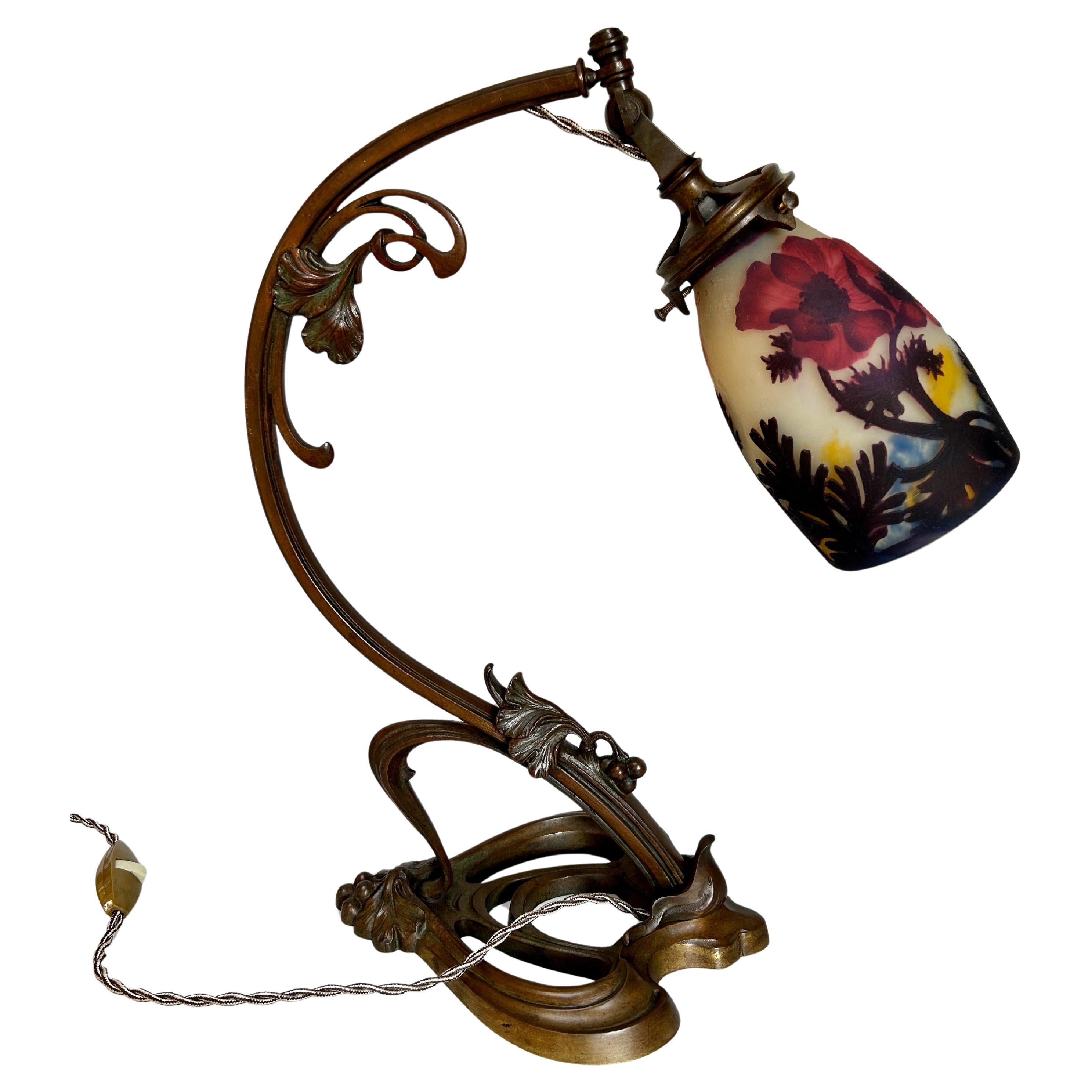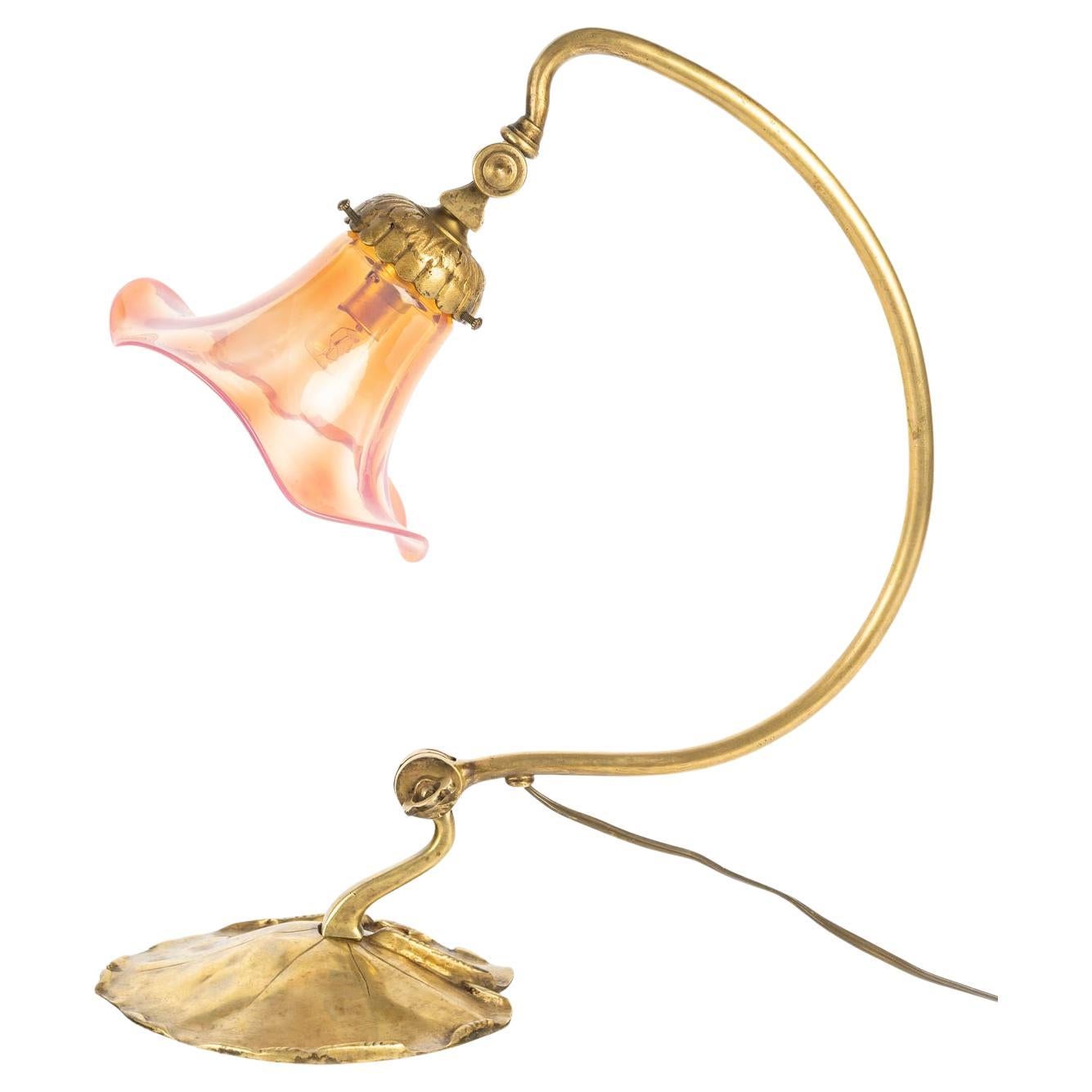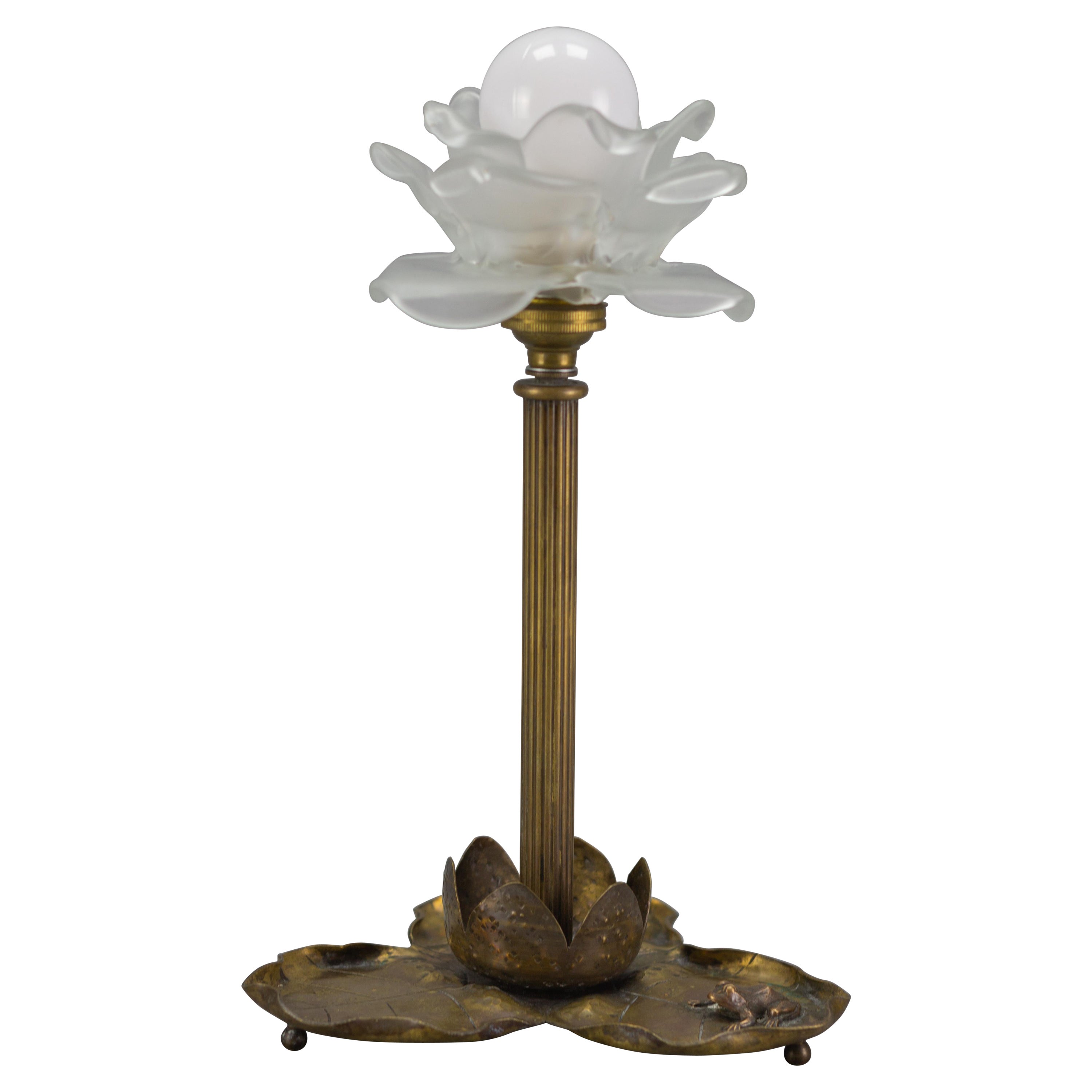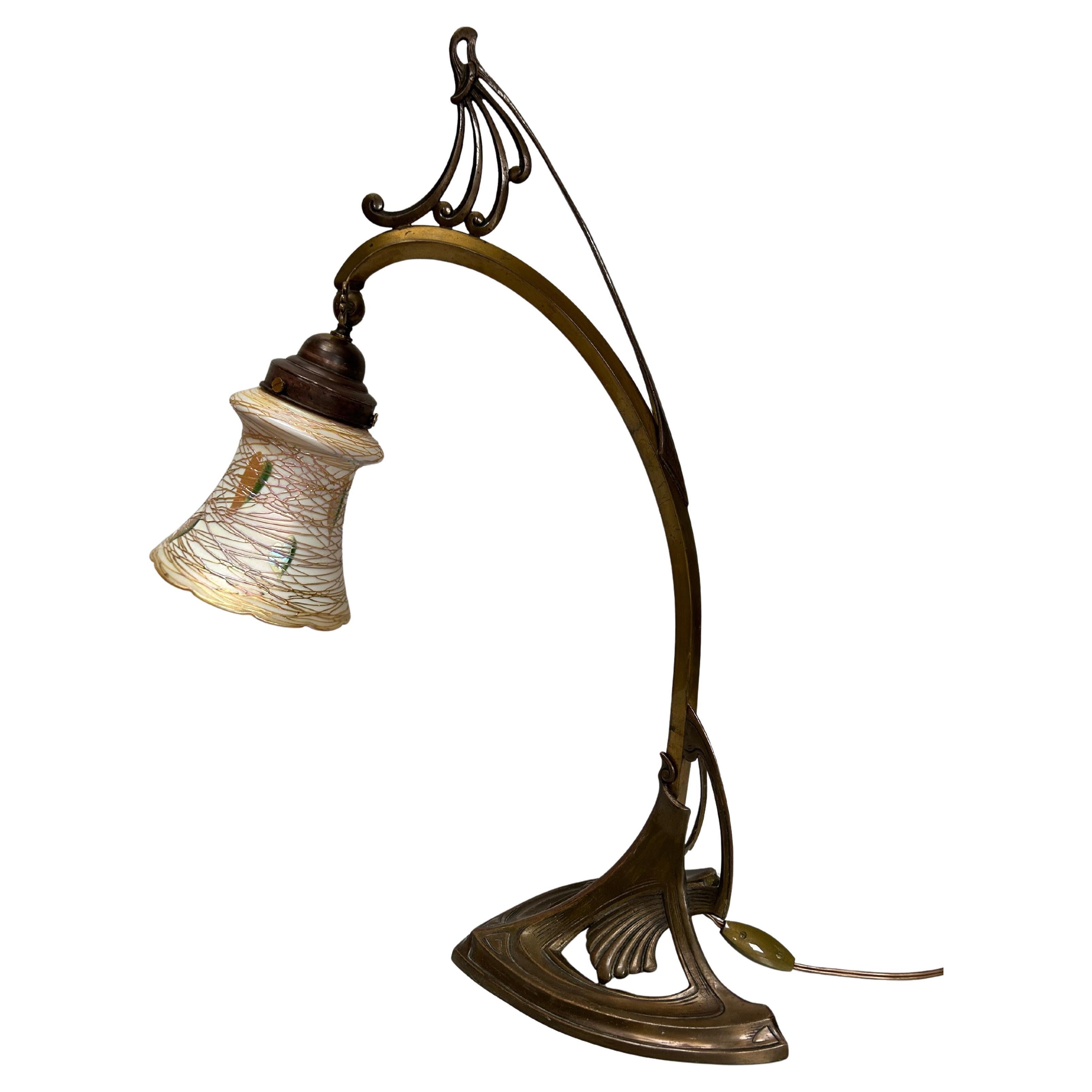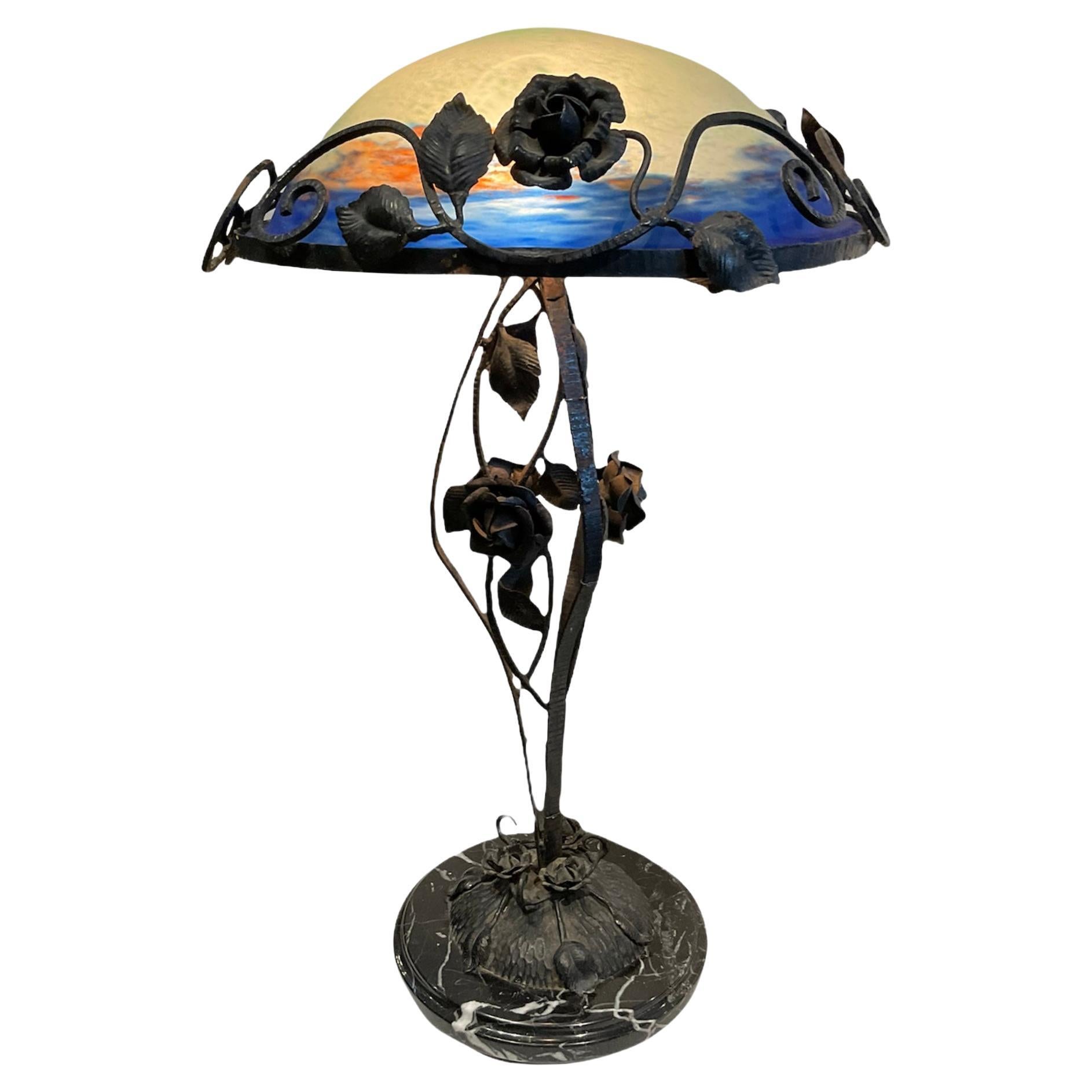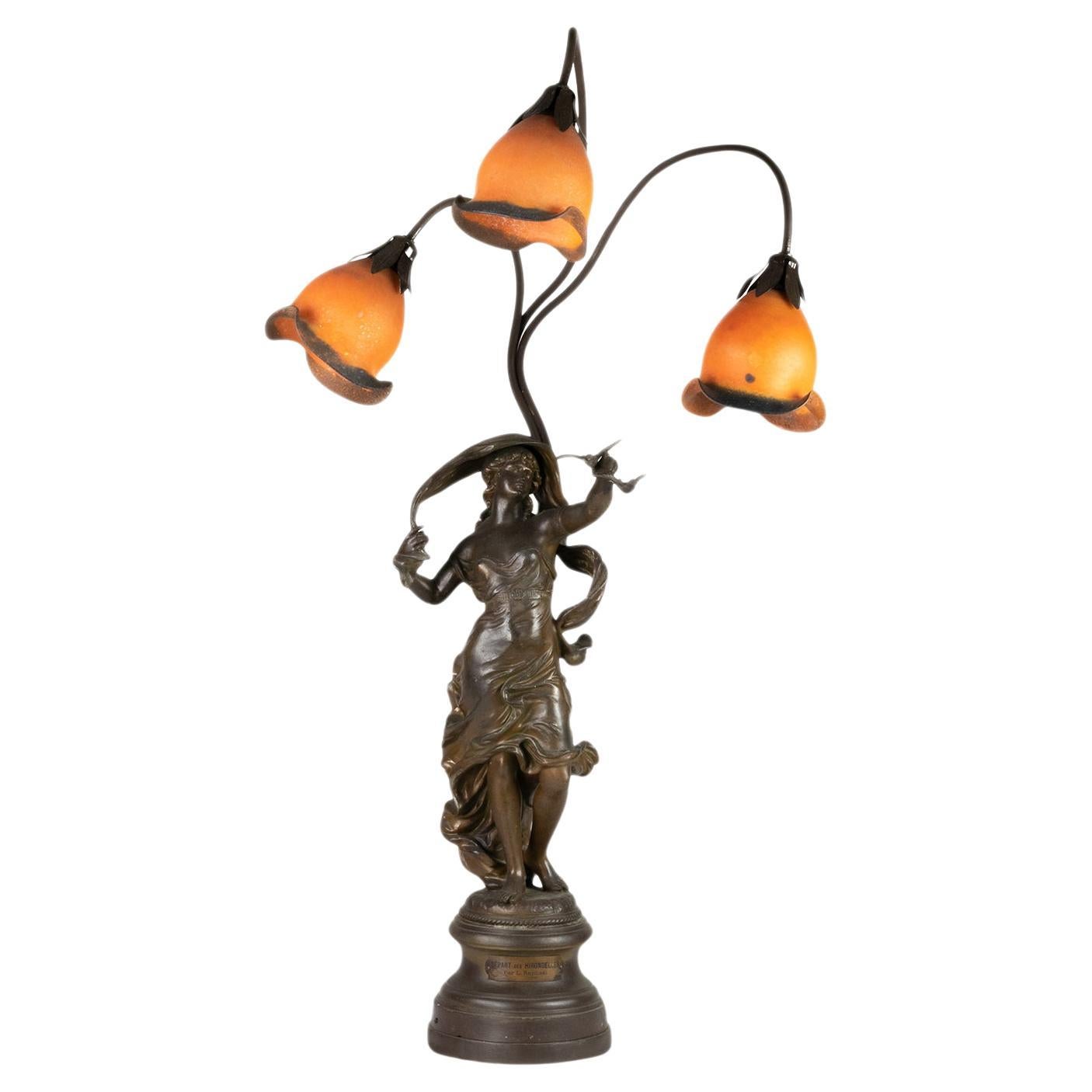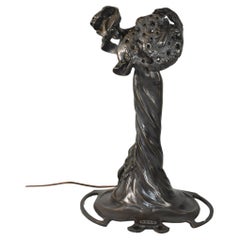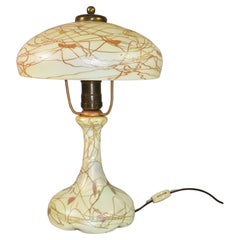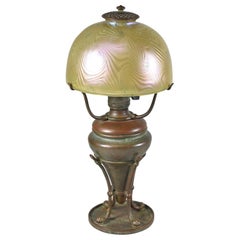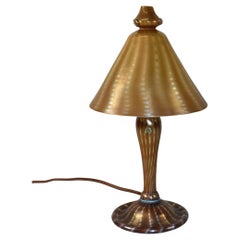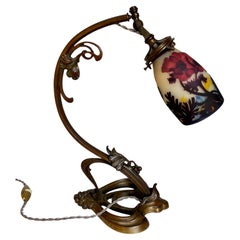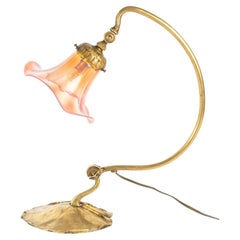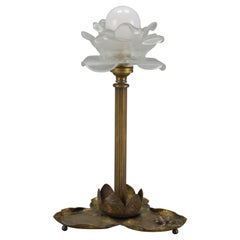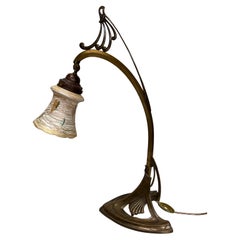Items Similar to 1910 Art Nouveau P. Rigual Lily Pad Motif Boudoir Lamp, 13" high, Quezal Shade
Want more images or videos?
Request additional images or videos from the seller
1 of 9
1910 Art Nouveau P. Rigual Lily Pad Motif Boudoir Lamp, 13" high, Quezal Shade
$2,000
£1,527.16
€1,738.73
CA$2,808.32
A$3,070.04
CHF 1,624.19
MX$36,737.95
NOK 20,665.47
SEK 18,917.15
DKK 12,987.23
About the Item
This turn of the century art nouveau boudoir lamp by P. Rigual is fitted with a Quezal shade. The bell form iridescent glass shade has gold threaded heart and vine decoration on a figural patinated spelter base, depicting a nymph on a lily pad. The cast base is signed with the P. Rigual signature and the shade is marked Quezal on the inside of the fitter. This lamp is 13" tall and the shade is 3 1/2" tall with a 2 1/4" fitter. This lamp has been rewired.
- Creator:
- Dimensions:Height: 13 in (33.02 cm)Width: 7.5 in (19.05 cm)Depth: 4.5 in (11.43 cm)
- Power Source:Plug-in
- Lampshade:Included
- Style:Art Nouveau (Of the Period)
- Materials and Techniques:Art Glass,Cast
- Period:1910-1919
- Date of Manufacture:1910's
- Condition:Rewired.
- Seller Location:Toledo, OH
- Reference Number:Seller: LW0607241stDibs: LU1658240088292
About the Seller
4.9
Gold Seller
Premium sellers maintaining a 4.3+ rating and 24-hour response times
Established in 1984
1stDibs seller since 2015
765 sales on 1stDibs
Typical response time: 4 hours
- ShippingRetrieving quote...Shipping from: Toledo, OH
- Return Policy
More From This Seller
View AllArt Nouveau Style Bronze Sculptural Table Lamp, Woman with Flowers, 19"
Located in Toledo, OH
This beautiful sculptural lamp of a woman with flowers is in the style of Art Nouveau. The flowers are pierced with the socket behind to show a gentle light through. Her gown swirls ...
Category
20th Century Art Nouveau Table Lamps
Materials
Bronze
Steuben Boudoir Lamp Art Glass, Gold Heart & Vine
By Stuben
Located in Toledo, OH
This stunning Steuben boudoir art glass lamp is decorated with gold heart and vines. This lamp has the original Bryant socket. The shade is 8 1/2" diameter and the lamp stands at 13 ...
Category
Early 20th Century Table Lamps
Materials
Art Glass
Tiffany Studios Boudoir Lamp with 7" Damascene Shade
By Tiffany Studios
Located in Toledo, OH
Early Tiffany lamp with a 7" damascene favrile glass shade on a bronze base in an oil lamp style with nice original patina. The shade has no chips; there are some bubble bursts that ...
Category
Antique Late 19th Century American Table Lamps
Materials
Blown Glass
Tiffany Favrile Art Glass Boudoir Lamp
By Louis Comfort Tiffany
Located in Toledo, OH
Beautiful early 20th century Tiffany Favrile glass boudoir lamp. The lamp features a conical glass shade and baluster base with gold/amber "Arabian" pattern discoloration and applied...
Category
Early 20th Century American Table Lamps
Materials
Art Glass
Pairpoint Reverse Painted Floral Table Lamp USA Signed
By Pairpoint Glassworks
Located in Toledo, OH
Pairpoint reverse painted eight panel table lamp. Two sockets with acorn pulls on silver plated engraved foliage base. 16" shade decorated with floral desi...
Category
20th Century North American Arts and Crafts Table Lamps
Materials
Glass
Handel Cherry Blossom Leaded Glass Lamp
Located in Toledo, OH
This stunning Handel Cherry Blossom leaded glass lamp is circa 1910. The 12" wide x 6" tall shade is decorated in pink flowers with multiple shades ...
Category
Vintage 1910s Table Lamps
Materials
Bronze
You May Also Like
Muller Frères Luneville Art Nouveau Lamp
By Muller Fres Lunneville
Located in NANTES, FR
Sublime Art Nouveau lamp circa 1905.
Bronze base, acid-etched glass paste tulip decorated with anemone flowers.
Electricized in the US and in perfect condition.
Signed Muller Frères ...
Category
Antique Early 1900s French Art Nouveau Table Lamps
Materials
Bronze
Art Nouveau Bronze Lamp, circa 1900, Signed C.Berlier, Lyon.
Located in Saint-Ouen, FR
Art Nouveau bronze lamp, circa 1900, signed C.Berlier, Lyon.
Art Nouveau period lamp in bronze and pink transparent opaline glass by C.Berlier...
Category
20th Century French Art Nouveau Table Lamps
Materials
Bronze
French Art Nouveau Brass Table Lamp with Frog, 1930s
Located in Barntrup, DE
Beautiful Art Nouveau brass table lamp in the shape of a water lily with a frog figurine on the base. White flower-shaped frosted glass lampshade.
One socket for a B22-size light bul...
Category
Vintage 1930s French Art Nouveau Table Lamps
Materials
Brass
Art Nouveau Lamp by Quezal
By Quezal
Located in NANTES, FR
Art Nouveau desk lamp, circa 1905.
Brass and copper frame.
Rare iridescent glass shade signed Quezal.
Electrified and in very good condition.
Height: 60.5 cm
Width: 21 cm
Depth: 35 cm
Weight: 2.6 kg
Quezal Art Glass
Quezal Art Glass – The Journal of Antiques and Collectibles – April 2003
By Malcolm Mac Neil
Some of the most beautiful and alluring art glass made in America during the early part of the 20th Century was made by the Quezal Art Glass and Decorating Company. Often in the shape of blossoming lilies with brilliant gold interiors and colorfully decorated with floral and other motifs inspired by nature, Quezal art glass ranks right alongside the iridescent glass of Louis Comfort Tiffany and Frederick Carder. Quezal artisans created an extensive range of decorative and useful items, including vases, compotes, finger bowls, open salts, candle holders, and shades for lighting fixtures, which are equivalent in terms of beauty and quality of craftsmanship to Tiffany’s Favrile and Carder’s Aurene glass. In recent years, glass collectors have discovered anew the special charms and appeal of Quezal art glass, and collector desirability for this lovely glassware has increased dramatically.
The Quezal Art Glass and Decorating Company was incorporated a century ago, on March 27, 1902. It was founded by Martin Bach, Sr., Thomas Johnson, Nicholas Bach, Lena Scholtz, and Adolph Demuth. The factory was located on the corner of Fresh Pond Road and Metropolitan Avenue in Maspeth, Queens, New York. In October 1902, the trademark “Quezal” was successfully registered. By 1904, roughly fifty glassworkers were employed at the works.
Martin Bach, Sr. was the president, proprietor, and guiding force behind this successful company. Born in 1862 in Alsace-Lorraine to German parents, he emigrated to the United States in 1891. Before his emigration, Bach worked in Saint-Louis, France, at the Saint-Louis Glass Factory. After Bach arrived in this country, he was hired by Louis C. Tiffany as the latter’s first batch-mixer or chemist at the newly established Tiffany Glass and Decorating Company, in Corona, Queens. After a period of about eight years, Bach left Tiffany and established his own glassworks. By this time, Bach had already started his small family. He and his German-born wife, Anne-Marie Geisser, whom he married in the fall of 1889, in Paris, France, had three children. Two daughters, Jennie and Louise, were born in France and a son, Martin, Jr., was born in Corona.
Bach was assisted by Thomas Johnson, an English immigrant, and Maurice Kelly, a native of Corona, both of whom were gaffers or master glassblowers. Johnson and Kelly helped pave the way for Quezal’s early accomplishments and later recognition. Thomas Johnson, like Bach, was a founding member and also previously employed by Louis C. Tiffany. Johnson’s association with Quezal, however, was relatively short lived. Around 1907, Johnson left for Somerville, Massachusetts, where he became involved in making Kew Blas...
Category
Antique Early 1900s American Art Nouveau Table Lamps
Materials
Brass, Copper
Degue Art Nouveau Style Hand Painted Lamp
By Degué
Located in Guaynabo, PR
This is a hand painted half moon shaped glass paste shade lamp mounted in a wrought iron stem branches of roses and leaves. The half moon shade depicts an orange and royal blue color...
Category
Early 20th Century French Art Nouveau Table Lamps
Materials
Wrought Iron
$2,000 Sale Price
20% Off
Art Nouveau Table Lamp With Cameo Tulips, 20th Century
Located in Lisbon, PT
An Art Nouveau table lamp titled "Départ des Hirondelles" (Departure of the Swallows), depicting a graceful forest nymph in flowing drapery, signed “L. Raphael” on the base.
This sc...
Category
20th Century French Art Nouveau Table Lamps
Materials
Metal
$2,746 Sale Price
25% Off
More Ways To Browse
Lily Pad
Antique Boudoir
Art Nouveau Lily
Lily Pad Table
Lily Pad Lamp
Antique Lily Lamp
Curtis Jere Chrome Table Lamp
Danish Table Lamp Glass Teak
Duck Lamp
English Art Deco Lamps
Female Nude Lamps
Figural Shaded Lamp
Flambe Lamp
Fossil Table Lamps
Francesco Buzzi Ceriani
Genie Lamp
German Antique Table Lamps
Ginger Jar Metal
